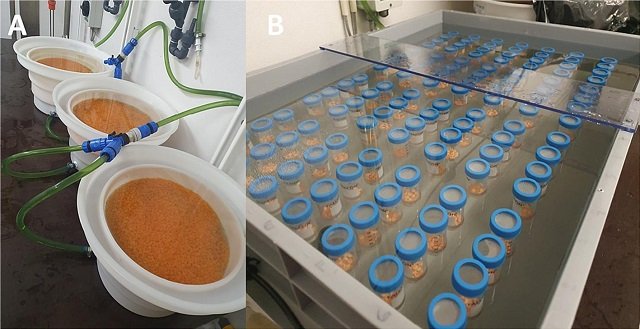
The journey from a single fertilized egg to a fully developed Atlantic salmon is a fascinating and delicate process. In the worlds of aquaculture and conservation, understanding the complexities of embryonic development is vital.
The rate of embryonic development in relation to temperature is of great interest to hatcheries, as it is used to estimate and manipulate hatching rates. For the optimal development of Atlantic salmon eggs, it is recommended to maintain a water temperature of a maximum of 8°C during the incubation process.
A recent study published by scientists from the Norwegian University of Science and Technology and Lerøy Midt AS provides valuable information about the normal embryonic development of Atlantic salmon eggs at an incubation temperature of 8°C, while shedding light on their sensitivity to mechanical stress during this critical period.
This knowledge can greatly benefit hatchery managers in making informed decisions about optimal handling routines.
Revealing Embryonic Development
Although the relationship between different temperatures and the rate of development has been widely studied, embryonic development concerning Atlantic salmon’s temperature has only been described by Gorodilov (1996), using tau-somite as a unit of development time.
However, as reported in the study, commercial hatcheries seem to have observed embryonic development that does not align with the timing described by Gorodilov.
In this regard, the study meticulously detailed and illustrated the normal embryonic development of Atlantic salmon eggs, from the moment of fertilization to hatching. This comprehensive analysis provides a roadmap of the stages an Atlantic salmon embryo goes through on its way to becoming an adult fish.
Understanding the different stages of development is crucial for maintaining the health and viability of these embryos. It also allows hatchery managers to establish appropriate schedules for the different stages of care and monitoring, ensuring optimal conditions for growth.
Stay Always Informed
Join our communities to instantly receive the most important news, reports, and analysis from the aquaculture industry.
Mechanical Stress and Sensitivity
One of the highlights of this study was the examination of the sensitivity of Atlantic salmon embryos to mechanical stress during the development stages. To assess this, a mechanical shock device was used to simulate the effects of mechanical stress.
Eggs were dropped from different predetermined heights, and the heights at which 10% and 50% mortality occurred, referred to as LD10 and LD50, were recorded.
The results of this mechanical stress test revealed a fascinating trend in sensitivity. It was found that sensitivity to mechanical stress increased from fertilization to the gastrulation stage. During gastrulation, the embryos were observed to be at their most vulnerable, making this a critical period for care and handling. The highest sensitivity was recorded at this point.
However, sensitivity to mechanical stress decreased as the embryos progressed through late gastrulation and reached the “eyed” stage. At this advanced stage of development, no mortality was observed at any of the heights tested. This suggests that the “eyed” stage marks a significant turning point in the embryo’s ability to withstand mechanical stress.
Implications for Hatchery Managers
The information gathered from this study has direct implications for hatchery managers involved in Atlantic salmon breeding. Understanding the specific developmental stages in which embryos are most sensitive to mechanical stress can guide decisions regarding optimal handling routines.
Hatchery managers can use this knowledge to implement appropriate care and protection measures during the critical gastrulation stage. This may include adjusting handling protocols, ensuring smoother transport methods, or increasing vigilance during this delicate phase of development.
By doing so, hatchery managers can significantly reduce the risk of mortality and ensure a higher survival rate among Atlantic salmon embryos, ultimately contributing to the success of aquaculture and conservation efforts.
Conclusion
The recent study not only provides a detailed insight into normal embryonic development but also reveals the sensitivity of embryos to mechanical stress during these crucial stages.
“The pattern of sensitivity, based on acute mortality 7 days after mechanical shock exposure, observed for Atlantic salmon was an increase in sensitivity from fertilization to gastrulation, during gastrulation, the maximum sensitivity was reached, and towards the end of gastrulation and subsequently when the blastopore closed, sensitivity decreased until no mortality was observed at the highest height tested during the ‘eyed’ stage,” the scientists concluded.
This knowledge is invaluable to hatchery managers and offers a roadmap to safeguard the well-being of Atlantic salmon embryos. By understanding periods of heightened sensitivity and vulnerability, managers can take specific actions to ensure the healthy development of these fish, promoting sustainability and conservation efforts.
The study has been funded by the Norwegian University of Science and Technology.
Contact
Luciana Alves Musialak
NTNU Department of Biology Centre of Fisheries and Aquaculture (SeaLab)
7491 Trondheim, Norway.
luciana.a.musialak@ntnu.no
luciana.musialak@leroy.no
Reference (open access)
Luciana Alves Musialak, Bengt Finstad, Knut Elling Bråthen, Elin Kjørsvik. 2024. Embryonic development and sensitive stages of Atlantic salmon (Salmo salar) eggs, Aquaculture, Volume 579, 2024, 740281, ISSN 0044-8486, https://doi.org/10.1016/j.aquaculture.2023.740281.
Editor at the digital magazine AquaHoy. He holds a degree in Aquaculture Biology from the National University of Santa (UNS) and a Master’s degree in Science and Innovation Management from the Polytechnic University of Valencia, with postgraduate diplomas in Business Innovation and Innovation Management. He possesses extensive experience in the aquaculture and fisheries sector, having led the Fisheries Innovation Unit of the National Program for Innovation in Fisheries and Aquaculture (PNIPA). He has served as a senior consultant in technology watch, an innovation project formulator and advisor, and a lecturer at UNS. He is a member of the Peruvian College of Biologists and was recognized by the World Aquaculture Society (WAS) in 2016 for his contribution to aquaculture.




